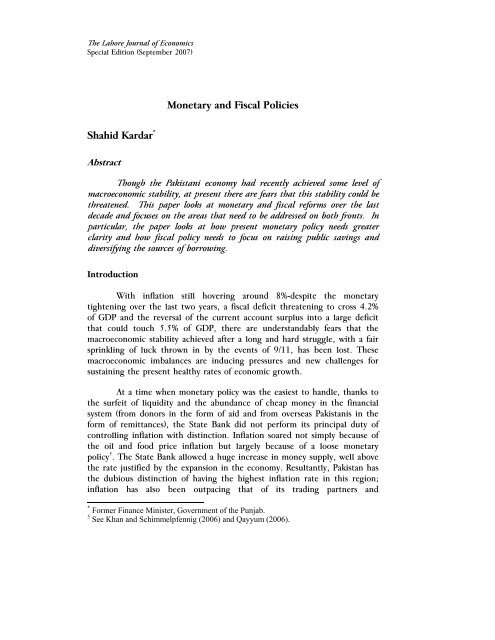Special Edition-07.pdf - Lahore School of Economics
Special Edition-07.pdf - Lahore School of Economics
Special Edition-07.pdf - Lahore School of Economics
Create successful ePaper yourself
Turn your PDF publications into a flip-book with our unique Google optimized e-Paper software.
The <strong>Lahore</strong> Journal <strong>of</strong> <strong>Economics</strong><br />
<strong>Special</strong> <strong>Edition</strong> (September 2007)<br />
Monetary and Fiscal Policies<br />
Shahid Kardar *<br />
Abstract<br />
Though the Pakistani economy had recently achieved some level <strong>of</strong><br />
macroeconomic stability, at present there are fears that this stability could be<br />
threatened. This paper looks at monetary and fiscal reforms over the last<br />
decade and focuses on the areas that need to be addressed on both fronts. In<br />
particular, the paper looks at how present monetary policy needs greater<br />
clarity and how fiscal policy needs to focus on raising public savings and<br />
diversifying the sources <strong>of</strong> borrowing.<br />
Introduction<br />
With inflation still hovering around 8%-despite the monetary<br />
tightening over the last two years, a fiscal deficit threatening to cross 4.2%<br />
<strong>of</strong> GDP and the reversal <strong>of</strong> the current account surplus into a large deficit<br />
that could touch 5.5% <strong>of</strong> GDP, there are understandably fears that the<br />
macroeconomic stability achieved after a long and hard struggle, with a fair<br />
sprinkling <strong>of</strong> luck thrown in by the events <strong>of</strong> 9/11, has been lost. These<br />
macroeconomic imbalances are inducing pressures and new challenges for<br />
sustaining the present healthy rates <strong>of</strong> economic growth.<br />
At a time when monetary policy was the easiest to handle, thanks to<br />
the surfeit <strong>of</strong> liquidity and the abundance <strong>of</strong> cheap money in the financial<br />
system (from donors in the form <strong>of</strong> aid and from overseas Pakistanis in the<br />
form <strong>of</strong> remittances), the State Bank did not perform its principal duty <strong>of</strong><br />
controlling inflation with distinction. Inflation soared not simply because <strong>of</strong><br />
the oil and food price inflation but largely because <strong>of</strong> a loose monetary<br />
policy 5 . The State Bank allowed a huge increase in money supply, well above<br />
the rate justified by the expansion in the economy. Resultantly, Pakistan has<br />
the dubious distinction <strong>of</strong> having the highest inflation rate in this region;<br />
inflation has also been outpacing that <strong>of</strong> its trading partners and<br />
* Former Finance Minister, Government <strong>of</strong> the Punjab.<br />
5 See Khan and Schimmelpfennig (2006) and Qayyum (2006).

















